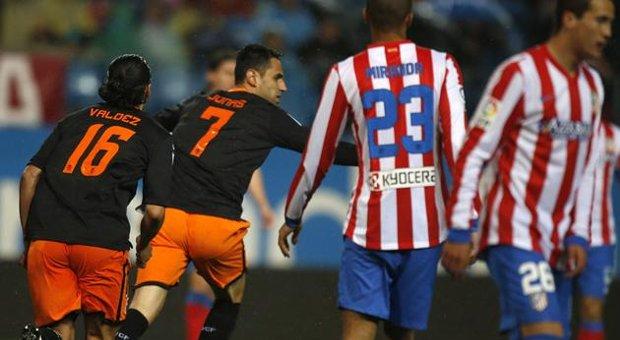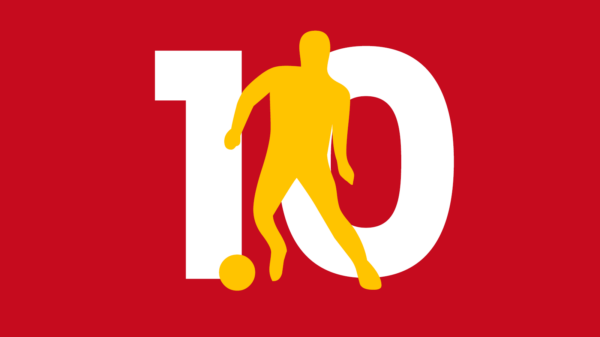A wet evening at the Vicente Calderón stadium, Atlético Madrid failed to capitalize on the opportunity to go 2nd following Real Madrid’s draw with Real Zaragoza on Saturday. Valencia had the chance to leapfrog Málaga and go level on points with La Real, but both teams had to settle for a point each – a game full of overloads provided a stalemate.
Line-ups

Atlético v Valencia – OOTB Tactics App
Atlético deployed their usual 4-4-2 which saw Diego Godín replace Cata Díaz in the heart of defence. Young Manquillo made his just his 3rd La Liga start at right-back in place of Juanfran – other than that, the team is the same which defeated Osasuna 0-2 last week.
Felipe Luis was allowed to push on, whilst Manquillo had a rather defensive game cutting out the overload from Éver Banega and Jonas. Mario Suaréz and partner Gabi in a more defensive role in midfield, whilst Koké was at the right side but continously drifted in. Arda Turan began on the left-side of midfield, but was substituted through injury on the 26th minute. Falcao and Diego Costa partnered each other up front.
Valencia were without key men Víctor Ruiz, Roberto Soldado, Sofiane Feghouli and Adil Rami which saw 3 changes from the team that beat Real Betis 3-0 at the Mestalla last week. Ernesto Valverde chose to use his favoured 4-2-3-1 formation.
Nelson Valdez was brought in as a replacement for Soldado and operated as the lone striker whilst Pablo Piatti was placed ahead of Jonathan Viera on the right wing. Ricardo Costa filled the centre-half spot which was vacated by Adil Rami and was joined by the make-shift centre-half by Jeremy Mathieu. Éver Banega filled the free role in the heart of the attacking play, whilst Andrés Guardado attacked the space ahead of him vacated by Koké. Tino Costa continued as the hard working pivot player whilst partnered by Dani Parejo as the primary holding pivot.
A Narrow Beginning
Diego Simeone set Atlético Madrid out in a formation which allowed as much of their creative, disciplined midfielders as possible. Koké was on the right hand side of midfield, and as a natural central midfielder, he drifted in a lot even though he has played as a right midfielder 13 times this season.
It seems as if Simeone had set-up his side to dominate the midfield, which would’ve been overloaded by Valencia’s Banega, Parejo and T.Costa. Albeit that the midfield was the same from the previous win over Osasuna last week, where the overload of the midfield had benefited the Madrid outfit perfectly. Against Los Che, it was quite the opposite. The attempted overload in midfield by Atléti saw Valencia divert to the flanks, where, especially on the left-hand side, they created a tremendous amount of danger.
The only source of width produced by any Atléti player was the full-backs – Manquillo on the right side and Filipe Luís on the left. This, though, proved to be not enough as Simeone’s side began to attack down the left side, targeting João Pereira who was left isolated by Pablo Piatti.

Atlético Madrid average positions – WhoScored.
As we can see from the image above, Manquillo (#26) and Filipe Luís (#3) offered the most width of all Atléti players. The midfield (#4, #6, #10, #14) are all based on the left side of the pitch with the exception of Gabi (#14) who is more centralised. Koké (#6) has vacated his right midfield position and has revamped the formation from a flat 4-4-2 to a 4-4-2 diamond. The space vacated by Koké was easily penetrated by Guardado and left winger Jonas, which caused the attacking threat of Manquillo to be limited as opposed to Filipe Luís limitations.
Success From The Flanks
Both sides appeared to attack the flanks which saw them produce respectful success. It has been mentioned that Atléti began to prioritise the left hand side of the pitch, Valencia meanwhile saw more success down their left hand side too. Koké’s vacation away from the right side of midfield produce a huge corridor of space which Guardado was able to expose to create an overload on 18-year-old full-back Manquillo.
Due to Manquillo’s ‘lack of experience’ as the the commentator;s cliché explains, he was unable to effectively keep both Los Che players away from the left hand side of Atléti’s 18-yard-box. Frequently, Miranda would come across, but couldn’t always due to the threat of Valdez and Banega, who the latter would also team up with Jonas and Guardado to create a 3 v 1 overload on Manquillo.

Primary attacking threats – Left/Atléti – Right/Valencia – WhoScored.
Above, we can clearly see that the primary focus of attacks by both sides were down the left-hand sides and perhaps more importantly down the flanks. Both sides were successful when creating chances from the flanks, which saw a combined amount of 41 crosses by both sides.
The deadlock in the centre of the pitch was the biggest reason as to why both sides began to attack the flanks. Banega was often cancelled out by Suaréz and Gabi, whilst Koké was ineffective when challenged by the wall of T.Costa and Parejo.
Whilst Koké mostly played in a more central position, he would revert to playing wider on the right hand side later on in the game when both sides were pushing for a winner. This change of position by the Spanish midfielder began to limit the amount of attacking freedom and threat by Guardado, who would see his attacking runs cut by a considerable amount.

Minimal action through the centre – Left/Atléti – Right/Valencia – Squawka.
Direct v Short
The style of play by both sides were different – Atlético were much more direct in their place whilst Valencia opted for a less direct approach. Whilst both sides did produce success and danger through their respective styles of play, Valencia got the upper hand by keeping possession more often and creating chances effectively in a patient manner.
Diego Costa and Falcao were playing up the top of Atléti’s 4-4-2 formation, and the aerial ability of both players would suggest that it would be wise to utilize this in a direct form of style. Their ability to also hold the ball up when waiting for support, whether it be from each other or the on rushing midfield also gave the direct style more sense. Mathieu and R.Costa matched Falcao’s and Costa’s aerial and hold-up ability through the art of interceptions (Mathieu and R.Costa recorded 12 interceptions between them – 60% of Valencia’s interceptions as a whole).

R.Costa and Mathieu interceptions – Squawka.
Even though R.Costa and Mathieu seemed to be dominant when it came to aerial ability and reading the play, Atléti still played a more direct style, which began to slightly favour the left flank – mentioned previously.

Atlético Madrid passes – Squawka.
On the other hand, Los Che optimized the less direct style – being patient when in possession and precisely choosing when to play the attacking third passes. Though, with this preciseness, their ability to find success in the attacking third was relatively poor.
Although they did control the middle of the deadlock field, they managed to string a great amount of passes through the middle as well as on the flanks which kept Los Che in control of the game, whilst Parejo and T.Costa were allowed to dictate the flow of the game which kept Valverde’s men in pole position.

Valencia passes – Squawka.
Last Throw of The Dice
Ernesto Valverde made use of all 3 of his allowed substitutions – Jonathan Viera replaced Piatti, Sergio Canales replaced Banega as the 2 like-for-like substitutions, but the first substitution was the one which made a change to Valencia’s approach.
Aly Cissokho came on for the ineffective Nelson Valdez just after the 65th minute, which saw the Frenchman go into the left-back position. This moved Guardado up into the left wing position – the position he was used most in at Deportivo – and Jonas from left wing into the out and out striker. Jonas’s style is a lot different to Valdez’ approach – Jonas is more of an all-round striker, with a touch of poacher as opposed to Valdez who is more of a target-man.
Whilst the combination of both Cissokho and Guardado down the left flank was heavily attacking, it was also effective when defending. Guardado’s work rate all game was undoubted – he was up and down the left flank as much time and space allowed him – so the combination of Guardado’s defensive contribution as a left winger partnered with Cissokho’s attacking threat from the deep full-back position still allowed that attacking threat from the left side of Los Che, but was stable when operating defensively.
Conclusion
Both sides approached the game differently – Atléti more narrow and direct, Valencia wide but less direct, but both sides still managed to create chances from their style of play, but both sides were unable to convert these chances into goals.
Atlético Madrid were poor, and rather fortunate to come away with a point, whilst Valencia can feel sorry for themselves. Valverde, since joining Los Che, has brought confidence and motivation to his players, and continue to climb the La Liga ladder in search of that final Champions League spot, but must utilize their chances and domination in games such as this if they can make that 4th spot.



























































